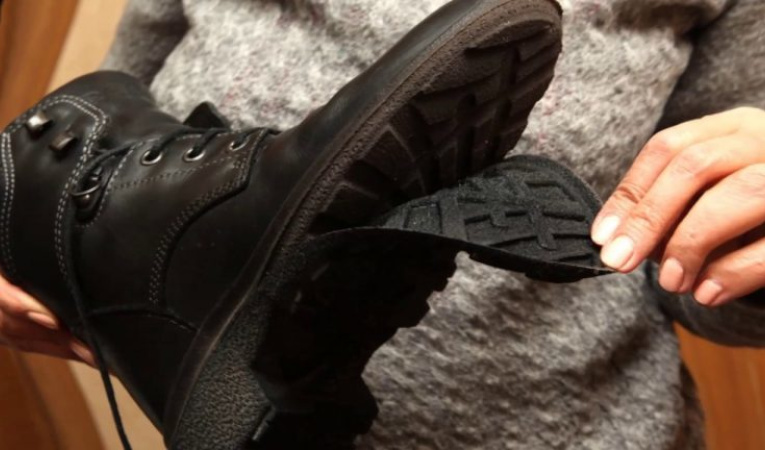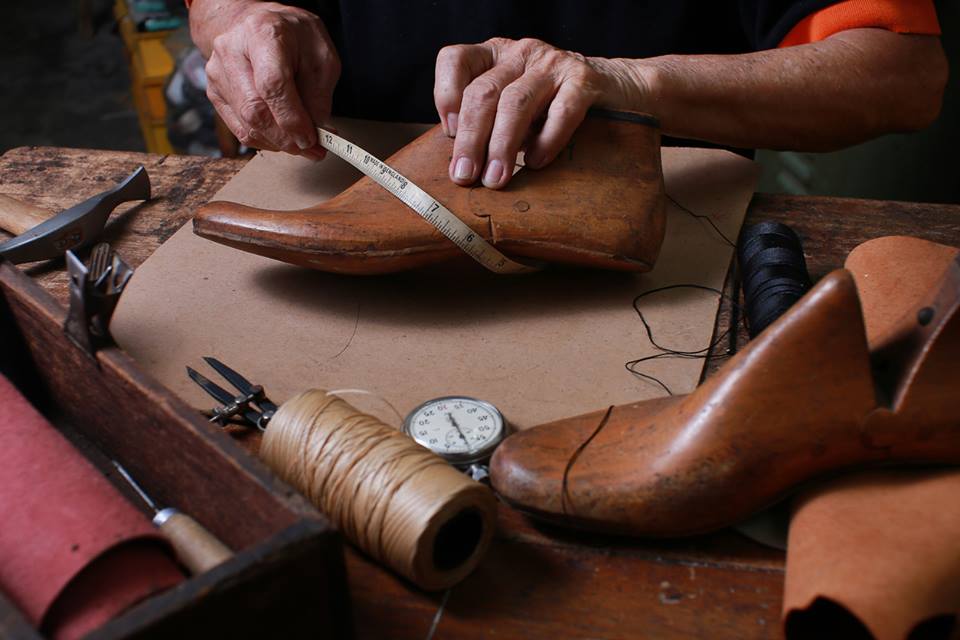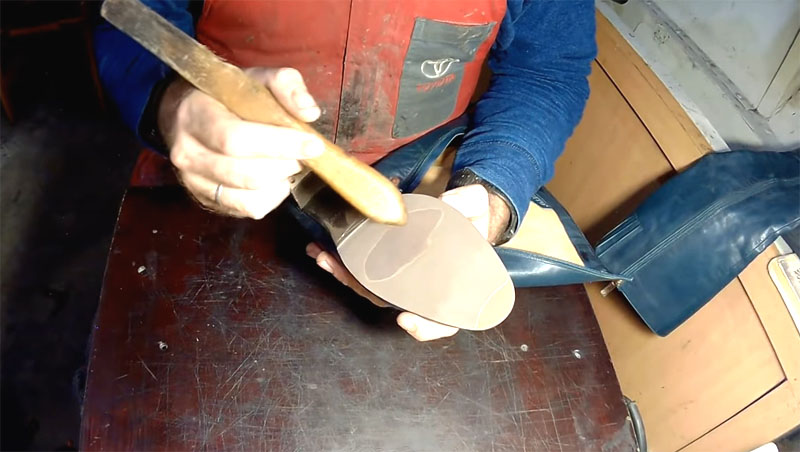You can also glue the cracked sole with special glue. Small tears in the heel area can be repaired in this way. Preferably in the place that is least stressed. You can also replace the damaged area.

- What to do if the sole breaks?
- Ways to patch a hole in the sole of a shoe
- rubber
- Glue
- Why the sole cracks
- Can I return the shoes to the store if the guarantee has not yet expired?
- Materials and tools to fix the problem
- repair methods
- attaching patches
- Gluing the fragment with a special glue
- Repairing a deep crack
- prevention
- Traditional methods
- Repairs to sports shoes
- How to avoid damage
- Causes of sole damage
- prevention of the problem
- Recommendations for repairing soles
- How to seal soles
- What the sole should look like after the repair
- Finally.
What to do if the sole breaks?
Over time, even the highest quality and most expensive shoes become unsightly. The most common form of damage is the sole. It wears out, cracks and holes appear. You can take the leaking shoe to be repaired or you can use improvised measures to fix the problem yourself.
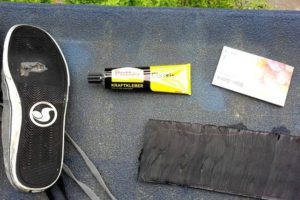
Before you can mend a hole in the sole, the shoes should be washed thoroughly and the dirt completely removed.. Proceed with the degreasing process. Put acetone or petrol on a cotton swab and wipe the sole. The shoes should then be dried.
Experts recommend drying shoes naturally and without heating devices. If the hole is clear, carefully remove the insole. Once the shoes are cleaned and dried, the repair can begin.
Ways to patch a hole in the sole of a shoe
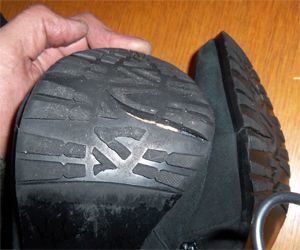
There are several methods to patch a hole. The most common way to combat the problem is with glue. Polyurethane compounds are recommended as adhesives.. They are reliable and durable. Sealant has good adhesive properties.
rubber
If you know how to work with leather, you'll love the rubber method of sealing the hole in the sole. Cut a square piece of rubber about 2mm larger than the hole in the sole. Coat it with glue on all sides and press it into the gap with a screwdriver or awl.
The rubber then acts as a spacer and the glue holds it in place and prevents it from flying out. Allow the shoe to dry for a few hours.
Glue
You will need glue in a tube with a long, narrow nozzle. It should be cut so that the tip fits into the hole in the sole. Follow the instructions:
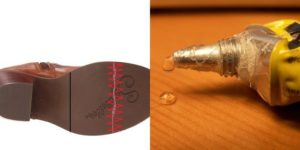
- Remove the insole from the shoe;
- Push a piece of leather into the hole on the inside (where the insole was);
- Squeeze enough glue into the hole to completely fill it;
- Hold the piece of leather in place with your hand for about 10 minutes until the glue sets;
- Let the shoe stand upside down and wait for the glue to set completely;
- Carefully cut the piece of leather that is on the inside of the shoe with a knife;
- Push the insole back into place.
Read more:Remember to wear gloves, a cotton gauze bandage or a respirator when working with the glue.
Why the sole cracks
The bottom of the shoe is often exposed to slush, frost, rain and chemicals. Deformations occur as a result of the mechanical stress. For this reason, special requirements are placed on the choice of material when manufacturing the sole. It must be robust, with maximum resistance to moisture and temperature changes. PVC products are also considered to be less flexible and therefore tend to break under severe flexing.
Another cause of cracks in the sole is its thickness. Very often manufacturers use microporous rubber. If this is of poor quality, the first damage occurs after just a few socks. The sole is also made of polyurethane, which is prone to cracking. This can occur even if the shoe has not been worn.
The most common cause is various mechanical damage. A person steps on a sharp object while walking, and after some time a crack appears. If nothing is done, dirt, dust and chemicals will gradually settle in the cracks. The tear gets bigger and bigger and eventually the shoe becomes unusable.
Can I return the shoes to the store if the guarantee has not yet expired?
When someone buys shoes, they hope that they will last at least one season, but in practice the situation is a little different. The reason that the product cannot be used may be a manufacturing defect. The buyer can return the shoes in store, exchange the goods or get a refund according to the legal regulations.
The amount of the guarantee depends on the requirements of the applicable law.
Also according to the law, in 2019 the buyer has the full right to receive information about the manufacturer of the product.
The following information may be requested:
Materials and tools to fix the problem
According to safety regulations, shoe sole repair must be carried out in a prepared room. To prevent the material used from igniting and to avoid toxic effects from the adhesive, the work area must be well ventilated and away from heat sources.
In order to quickly mend a torn sole, the following materials and tools should be prepared
- A sanding pad with a strength of 0 to 3;
- degreasing agents;
- a shoemaker's knife;
- Awl;
- Pencil;
- hair dryers;
- special yarn;
- metal hook;
- Glue;
- Matches;
- raw material for patchwork;
- a heavier object than weight.
The end result directly depends on the type of working material. It is best to choose a piece of hard leather for repairing soles. Use gasoline as a degreaser. The adhesive should be matched to the material of the substrate.
repair methods
There are several ways to seal a torn sole at a crease. Each method requires some preliminary work. In order to effectively repair a defect in a shoe, it is advisable to remove dirt from the bottom of the shoe, rinse it with a degreasing agent and dry it thoroughly with a hair dryer. The technological process then depends on the type of model and the complexity of its deformation.
attaching patches
Repairing a cracked sole with a patch is not as easy as it might seem at first glance. However, it is possible to get the best results. Start by carefully separating the upper from the sole with a screwdriver. This makes work easier and helps the glue stick well.
It is recommended to glue the torn shoe in this order:
- Peel off the shoe material 1 cm from the granitol;
- prepare the patch - its length must correspond to the size of the hole;
- coat the inner through hole of the shoe and the tongue of the patch with glue;
- attach half of the patch between the fabric and the granitol;
- put the parts together and dry the connection with a hair dryer;
- Clean the inside of the sole with acetone;
- then smear them and the other part of the patch with glue.
Leave the shoe in this position for 12 hours. After that, dry the glued parts with a hair dryer. Then, with careful but quick movements, glue the other part of the patch and the inner surface of the sole. Finally, the insole is connected to the bottom of the shoe with Rapid. This is a good solution when the soles of summer and mid-season shoes are cracked.
Gluing the fragment with a special glue
This rehabilitation method is used on flat soles made of polyurethane or flexible rubber. The restoration of the products requires a certain level of knowledge and skill in carrying out the work. In addition to gluing the tears, they must also be sewn with kapron thread.
Repairing a deep crack
Sometimes the crack in the sole is so deep that it almost splits in half. In this case, it is better to glue the tear with a patch cut from the rubber of the bicycle device.
Prepare clean, dry, and degreased shoes by cutting along each edge of the tear with a sharp cobbler, then smoothing down the sides of the defect. The depth of the cut should not exceed 1 mm. A patch is then cut out. The width of the patch is the depth of the tear plus an additional 15mm.
Important: The patch should also be cleaned and degreased beforehand.
- The rubber piece is coated with polyurethane glue - completely on one side and 5 mm from the edge on the other side.
- We bend the sole to expose the tear, spread the glue on the inside and leave it on for 5-10 minutes.
- We bend the braces strip in half and glue it into the cavity, then we straighten the sole.
- Press the edges of the elastic firmly against the surface of the sole.
- The shoe is pressurized for 24 hours, after which it is wearable.
With diligence and a little imagination, you can repair shoes that appear unusable at first glance. All you have to do is buy a good quality glue, invest 5 minutes of your time and get a great result.
Handmade Cracked Sole Repairs: A Quick Fix Using Glue, Thread, and Patches Handmade Cracked Sole Repairs: A Quick Fix Using Glue, Thread, and Patches
prevention
For the warm summer months and for those who drive a lot or use shoes in the office, 1mm thick polyurethane stickers are an excellent choice. If you often walk on asphalt, a 2mm thick summer polyurethane sticker is preferable.
In the colder months, winter boots and shoes use thicker anti-slip protection with maximum abrasion resistance. The preventive measure is usually sufficient for one season.
Traditional methods
To reduce wear on the sole and prevent moisture from escaping from the seams, it is advisable to lubricate the sole and seams with castor or linseed oil before using the boots. Glycerin or a mixture of equal parts lamb fat and wax can also help.
For minor damage, you can try to repair the shoe or other shoes yourself. A small hole can be sealed with silicone sealant. Once the caulk completely fills the hole and dries, the repaired shoe can go outside without worrying about moisture.
If the damage is more severe, the tear can be sealed with a special polyurethane horseshoe and thick superglue, or you can contact a shoemaker.
Repairs to sports shoes
If the sole is worn in the toe area, it can be repaired by gluing 2 patches together. Cut 2 patches of different thicknesses from polyurethane or rubber. Sand the places where they will touch the bottom of the shoe. Glue the thicker patch to the imperfection and the smaller patch to the rest of the sole. Put a weight on the sneakers or athletic shoes for 24 hours.
You can also repair your skates by sticking on a patch if the defect did not occur where the blade was attached.
How to take care of your shoes so they don't get wet is an important knowledge for anyone who doesn't want to buy new shoes or…
How to avoid damage
To avoid this problem, you should follow the following rules:
- Buy shoes with a bottom that has good performance characteristics;
- Consider the weather conditions you will be wearing the shoes in;
- Don't neglect the care instructions;
- If possible, avoid stepping on sharp objects on the road.
A popular recommendation is to immediately lubricate the sole with glycerin, wax or castor oil.
Causes of sole damage
Why do soles break and how do you mend a torn shoe? Let's look at the main causes of cracked soles and more:
- The first is an uncomplicated issue with the material from which the sole was directly made. For example, PVC soles break quite often, they are not flexible enough and can be severely damaged by excessive flexing.
- The second reason is the thickness of the sole itself. Thick soles are often made of polyurethane foam or microporous rubber. If your sole is made like this, it's likely to break. Yes, such soles are resistant to any kind of flexing, but they don't make friends over time when they start to deteriorate.
- The third reason, the most common, is when you bump into something sharp. Note that even a small hole becomes a serious problem if left unused.
- Another reason is the time of year. Shoes are known to break more frequently in winter, due to the effects of severe cold weather and the chemicals used to clear the streets of ice.
Let's talk if there is a way to prevent this.
prevention of the problem
So that you don't have to wonder how to fix the soles of your shoes when they break, here are a few tips to keep in mind:
- When buying shoes, make sure that the sole is flexible and made of high-quality material. Rubber and polyurethane soles are preferred.
- As strange as it may sound, don't squat down. Yes, yes, that's why the shoes start to deteriorate, the horns crack and the soles break.
So let's get to the actual solution.
Recommendations for repairing soles
Before you start, you should clean, dry and degrease your soles. Use a special degreasing solution, petrol or acetone. Dry them off again after treatment.
Choose the load so that the shoe does not deform. An L-shaped shoe with added weight is best. Press the shoe for at least ten hours.
Apply glue up to 3mm thick and leave for ten minutes before gluing the parts together. Only choose a good quality and proven adhesive. The classic Moment adhesive, a polyurethane product or an epoxy sealant are suitable. You can also use special rubber shoe glue or cobbler's glue.
According to experts, the best remedy is polyurethane glue due to its strength and flexibility. It provides secure fixation and can restore any type of shoe. Either way, these are toxic compounds, so make sure you work safely. If the product comes into contact with your nose or eyes, immediately flush the mucous membranes with running water.
Be careful when working as the glue can damage the material of the product, especially suede, leather or patent leather shoes. The glue is very difficult to wash off. What to do if the soles of your shoes tear?
How to seal soles
If your shoes are slightly torn around the edges, you can mend them with the right glue. Clean and dry the leather, degrease the surface of the shoe to allow the glue to set properly and ensure a good bond. Then apply the mass to the areas and leave it on for ten minutes. Then glue the shoe together and weigh it down.
To mend the tear in the sole, walk five centimeters away from the tear towards the heel and draw a parallel line. Sand the area from the line to the toe including the crack with sandpaper. Then glue the tear with Moment glue and mark the thread holes.
Remove the insoles from the shoes, take a cobbler's knife and cut small holes according to the markings. Then sew through the resulting grooves with strong thread. Coat each seam with glue and let dry. Sand and degrease the sole again, then paint with micropores and tighten.
Sand the crack inside and degrease it. Score the edges of the sole one millimeter deep and press in five millimeters on each side. Then make a rubber patch of the right size with a spare.
A bicycle inner tube is suitable for making the patch. Sand and degrease the material, completely cover one side with glue and leave five mm of dry edges on the other side.
Bend the cracked sole so that the crack opens up and coat with glue. After the glue has dried slightly, stick a rubber patch in the damaged area and align it. Leave it under stress. The above methods will help if the sole of your boots, ankle boots or shoes is cracked.
You can seal the hole in the sole with silicone sealing glue. Stick it on the inside of the shoe under the insole. Carefully insert the open glue into the hole and fill it completely with the compound.
What the sole should look like after the repair
Of course, the color of the micropore patch differs from the color of the sole. There are several ways to hide the discrepancy, but why would you do that when it's on the sole? Over time, the stain will gather dust and become invisible.
The same goes for the toes. This part of the sole should also be sanded down thoroughly. In principle, such work cannot be called too difficult. But only if you only do them very rarely and for yourself. However, the work of a professional shoemaker is not easy. You have to imagine that this work has to be done many times faster, while at the same time the flow of different shoes and boots never stops. Surely the shoemaker is very tired in the evening.
Finally.
In anticipation of sarcastic comments that the shoes should have been thrown away, we would like to say that, given the constantly increasing prices in Russian stores, such a repair for 40 % of our population is the only way out of the current situation. So you don't have to think for a moment about where to get the money for new shoes. And today we also talked about how to spend your time wisely in self-isolation. So, this option is useful not only to save money, but also to banish gloom and boredom.
We hope that the information presented today will help the esteemed reader to save family budget and get rid of quarantine misery and boredom. If you still have questions, ask them in the discussions below, the Homius editorial team will be happy to answer them. You can also comment on what you've read or give your opinion on whether you should get your shoes repaired if the sole is torn. Let's discuss the topic and see which position will have more followers among our readers.
And please don't forget to rate. Your opinion is very important to us.
The Homius editorial team invites housewives and craftsmen to write articles for the 'Stories' section. These helpful first-hand stories will be published on the pages of our online magazine.
- The sole is worn.
- Rubbing heel in shoes.
- The sole in the heel area has sunk in, what can you do about it?.
- Damaged insoles in shoes - what to do?.
- Shoe sole to buy.
- Rubbing the heel.
- Mortar for soles.
- The sole in the shoe is responsible for.

